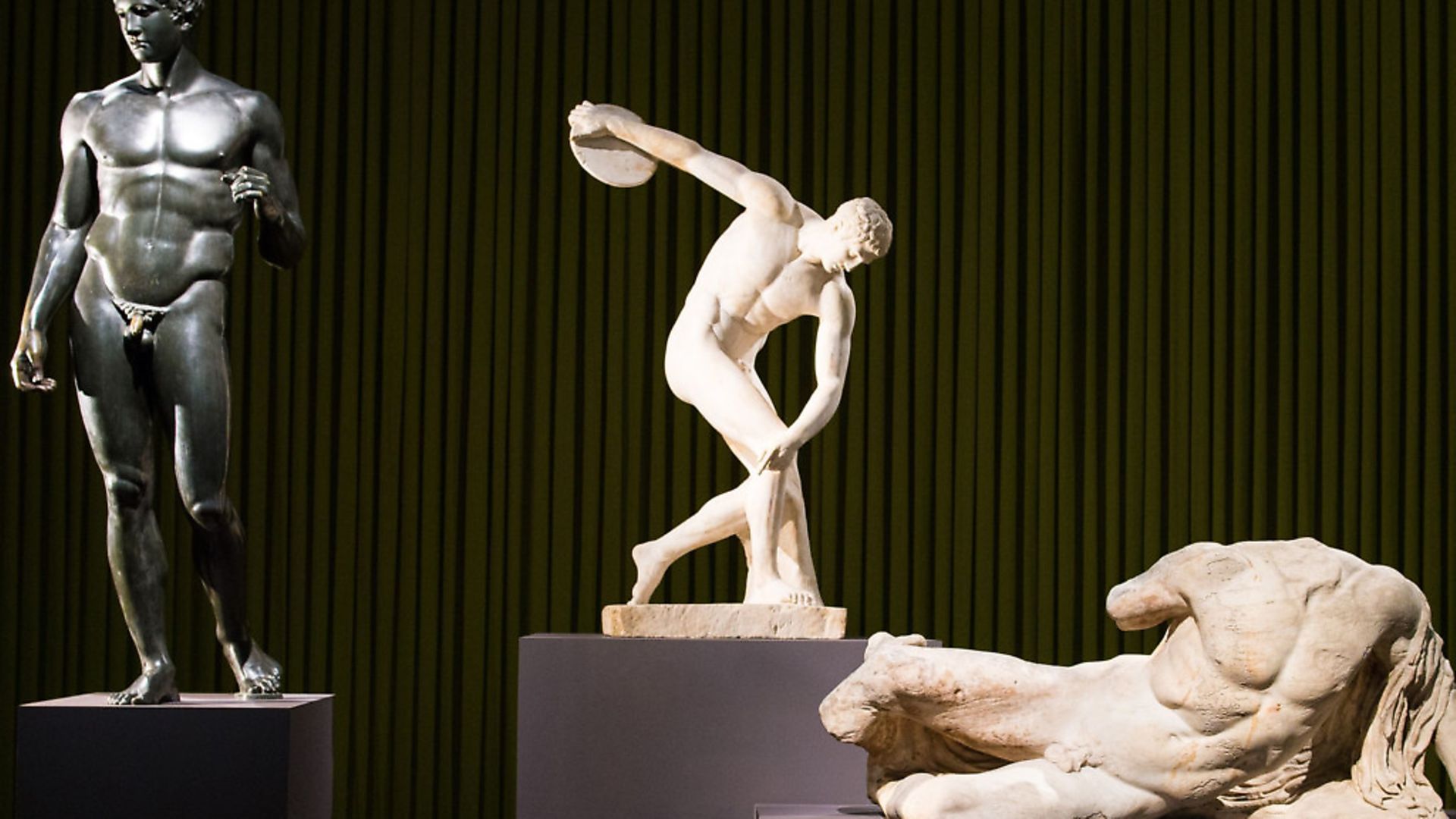
SOPHIA DEBOICK looks back to the period in Ancient Greece when music as we know it began.
Ancient Greek civilization was at its zenith in the mid-fifth century BC, as was clearly apparent in its art. The sculptor Myron was in the most active phase of his career and created his Discus Thrower, a sculpture that would become visual shorthand for the civilisation. The rampant masculinity of the Riace bronzes, dating to 460-420 BC, indicated the sheer virility of Greek culture in its Classical age.
The Parthenon was halfway through its decade-long build and was a project symbolic of Athenian confidence, the city state having reached terms with its enemies and consolidated its power by 440 BC. The violent physicality of the Parthenon’s marble metopes was the result of the experiences of the Greco-Persian War and a strident statement of Athenian military might.
Greek genius was also defining other branches of the arts. Father of tragedy, the playwright Aeschylus, who had died perhaps 15 years before 440 BC, is credited with pioneering the costuming, set design and interaction between performers familiar in theatre today. Meanwhile, Herodotus was busy creating the discipline of history “in the hope of thereby preserving from decay the remembrance of what men have done”.
But while the treasures of art and literature remain bold and vivid, only a few fragments of music from the Golden Age of Greece survive. Yet evidence from art and myth allows us to grasp a musical culture that embraced both darkness and levity, before simmering hostilities between Athens and Sparta threatened Greek cultural supremacy.
The very word music is Greek, and was originally used only adjectivally just like other words the civilisation created for its fine-grained conception of intellectual pursuits, from rhetoric and dialectic to tragic and comic, arithmetic and geometric.
Mousiká included theatre, poetry and dance as well as music, and was the ‘craft of the Muses’, a concept introduced in the odes of lyric poet Pindar, who was aged nearly 80 at this time. One of the earliest references to mousiká appears in a verse by poet and dramatist Epicharmus, who died around 440 BC, which mentions a “well-voiced” woman who is “equipped with all the mousiká” and “a lover of the lyre”.
Indeed, mousikos was an epithet synonymous with good taste, while amousikos would imply a lack of refinement and education, and music was of deep scholarly interest. The not long dead Pythagoras had formulated a theory of the significance of numbers in music, his study of harmonics and concept of the mechanics of the cosmos, expressed as ‘the music of the spheres’, and by 440 BC pitch had been analysed and understood and musical notation introduced.
But music was far from just an academic interest, and the often bizarre world of Greek myth was riddled with references to it. Three of the nine Muses, the daughters of Zeus, were divine musicians: Erato played the stringed kithára; Euterpe an aulós, a flute-like double pipe; Terpsichore the lyre.
Apollo was god of music, although it was his younger brother, Hermes, who was credited with inventing the lyre that was Apollo’s attribute, killing a tortoise and fashioning an instrument out of it as an infant. An early fifth century BC kylix (a shallow wine-drinking cup) in the Delphi Archaeological Museum shows Apollo in full splendour, with elaborate hairdo and a myrtle wreath, holding just such a turtle-shell lyre, known as a chelys.
Apollo was also involved in the creation myth of the aulós. After Perseus beheaded Medusa, Athena chanced across the aulós and was fascinated by how it imitated the mournful cries of Medusa’s bereaved sisters. But the vain goddess did not like how blowing the pipes distorted her face and discarded them. They were taken up by the satyr Marsyas who mastered aulós-playing, but when he got into a musical contest against Apollo he couldn’t match the divine musician’s talent and was subsequently flayed alive. Myron created a sculpture group of Athena and Marsyas around 440 BC which originally stood at the Acropolis and captured the moment the aulós passed from the divine Athena to the mortal Marsyas, underscoring the Greeks’ conception of music as the gift of the gods to men.
While the lyre and aulós had divine creation myths, the surviving objects from the middle of the fifth century BC show that these instruments were hardly rarefied. Pairs of aulós survive from this period and artistic sources reveal even the finest of details of the business of instrument-playing, as with the depictions of aulós players wearing phorbeiá, a leather strap worn round the back of the head and over the lips to support the cheeks while blowing – a typical Attic vase in the British Museum, for example, shows a professional musician sporting the strange headgear. There was a clear truth to Athena’s concerns about the physical exertion involved in playing the aulós, and by around 450 BC the sense that it was a coarse instrument led to it going out of fashion among the many ordinary citizens who had once played it.
Stringed instruments were considered more refined and, along with the chelys, the more complex kithára, the ancestor of the guitar with a box frame, is widely-seen in visual sources, indicating that music was a key part of everyday life.
Music had myriad uses in Ancient Greek society. It was inseparable from poetry – lyric poetry was by definition accompanied by a lyre and included everything from the skolion, a communal and celebratory drinking song, to the epinikion (victory ode) and threnos (lament).
Threnoi by both Pindar and his bitter rival Simonides of Ceos survive, as do skolia by Pindar, along with his First Pythic Ode, which celebrated the victory of the Sicilian tyrant Hieron of Syracuse in the chariot race at the 470 BC Pythian Games.
Music figured in games of all types, and the Olympics were at their height in the mid-fifth century BC, symbolised by the monolithic statue of Zeus at Olympia being commissioned not long after 450 BC.
Music of course also had huge religious significance, and in a slightly earlier period the dithyramb, a dance in honour of god of wine Dionysus accompanied by choral song and the aulós, had been popularised by Lasos of Hermione, reputed author of the first book on music.
Unsurprisingly, music was also a key part of the sacrificial cult of Apollo, the aulós being an instrument with ritual significance and often shown in scenes of processions or sacred spaces in the art of this period.
Indeed, music had a totemic significance in Ancient Greece, and its dark power was central to many Greek myths. It could enchant and entrance for treacherous purposes, as when the beautiful sorceress Circe tempted Odysseus’ crew with her singing and then turned them into swine. The song of the Sirens lured sailors to their island where they would become stranded
During the voyage of Jason and the Argonauts, Orpheus saved the crew from disaster by drowning out the Siren song with his lyre, and Orpheus’ life story intertwined music with love, loss, sex and death. Some accounts had it that Apollo himself tutored him in the lyre, while the Muses taught him to sing, and his voice had the supernatural power to charm living creatures and move inanimate objects.
After the death of his wife Eurydice on their wedding day, Orpheus retrieved her from the underworld, the gods allowing him to take her away on the condition he did not look back at her. When he did, he lost her for a second time.
His later sexual preference for young men drove the Thracian women to kill and dismember him in a fit of jealousy, and his still-singing head floated to the island of Lesbos, an event depicted with extraordinary vividness on a hydria (water-carrying vessel) of around 440 BC in the Antikenmuseum, Basel. Music could be light and festive in the Ancient Greek world, but it was also respected as a deeply powerful force.
The fall of Athens in 404 BC at the end of the first Peloponnesian War saw the city state reduced to a state of disease and famine, its fleet destroyed and its defensive walls dismantled.
Being brought so low had as great an impact on its culture as the victories of the past had. Music was as affected as everything else, and Plato had cause to complain of the wildness of the new style that emerged, using “high musical talent, showmanship and virtuosity” but “consciously rejecting educated standards of judgement”.
There was also a change from the monophonic music that had dominated in the past – the few bars of notation from Orestes by Euripides, composed in 408 BC and found on a later papyrus fragment held in the Austrian National Library, indicates that more than one note was to be sounded at once when it was played.
The headword of the fragment, katolophyromai, meaning ‘I cry, I lament so much’, foreshadowed the fall of Athens and it would never regain its cultural supremacy as new powers rose. But the omnipresent influence of Greek music in Roman culture saw it live on, and this was a period that marked the birth of music as we know it.











